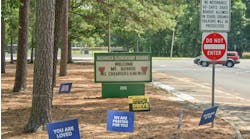These days, even that third little pig — the one who built his house out of bricks — might be smart to watch his back.
In the next 12 months, experts predict that five major hurricanes and 800 tornadoes will strike in the United States and cause millions of dollars in property damage. Earthquake research suggests that the southern end of the San Andreas Fault near Los Angeles could rupture at any moment. Researchers have been making similar prognostications for years about the New Madrid Fault in the Midwest.
The number of natural disasters and the number of people affected by them has been increasing worldwide over the past century, according to the Center for Research on the Epidemiology of Disasters. The reasons for this are the subject of much debate. But in some ways, it almost doesn't matter. Little can be done to prevent them.
What can be done is to minimize the destruction they cause. As seismologists are fond of noting, “Earthquakes don't kill people. Buildings kill people.”
And they are right. It was not the enormous shock waves of energy released during the 2005 earthquake in Pakistan or the powerful 140-miles-per-hour winds in Hurricane Katrina that caused most casualties. It was how manmade structures reacted to those forces that determined the severity of these disasters.
The impact of natural disasters can be lessened by making buildings less vulnerable. By studying structures that failed or suffered damage following earthquakes and storms, researchers now know more about why buildings fail and how to improve their ability to withstand such disasters. School and university administrators should pay attention to these findings because communities often rely on their buildings to serve as shelters in a catastrophe.
All forms of disaster are not created equal. The reasons a school building might fail in an earthquake are different from the reasons that same building might fail in a tornado or hurricane. A lightweight wooden structure might survive an earthquake but be destroyed in a tornado, just as a much stronger, but brittle concrete structure might fare well against high winds, but poorly in an earthquake. Designers must understand how these natural events affect a structure and strike a balance that minimizes the greatest threats in any geographic region.
Earthquake zone
Earthquakes simultaneously move the ground from side to side, and up and down. The force behind this movement is powerful enough to turn soft soil into quicksand instantly, slide a building off its foundation, or worse.
One of the primary reasons buildings fail in an earthquake is soil failure. When an earthquake hits, it's as if a building is being shaken back and forth in a pool of gelatin. When the shaking finally stops, these buildings sometimes are found slumping into the soil. Taller buildings — or those built of rigid concrete — may stay intact, but topple over in unstable soil. Soil failures such as this were the reason for much of the $4 billion damage in the 1985 Mexico City earthquake.
The irregular, multi-directional and intense side-to-side loads that occur during an earthquake can lead to other types of building failure as well. When a foundation moved by shock waves is not strong enough to pull the structure above along with it, the building can slide off its foundation.
Or in some cases, the intense shaking can leave the upper levels of a building intact until the lower floors crumble. This happens most often when a structure is constructed atop a parking garage or expansive ground-floor lobby. These lower-level floors — known as “soft floors” — typically are less rigid than the ones above them. Because they represent a break in the building's structural continuity, they are susceptible to failure when the ground shakes.
Some school and university buildings are especially at risk because they have had multiple additions and expansions. The problem, at least with many older buildings, is that newer additions are connected rigidly with the old buildings, even if they are of different heights and construction materials.
If these connections don't allow the different structures to move independently of each other, or if there is insufficient clearance between the different structures, the results can be disastrous. The strongest part of one building may be slammed repeatedly into the weakest part of the other, resulting in catastrophic failure simply because of proximity to its neighbor.
The design lessons here are numerous. In an earthquake zone:
-
Avoid building on sites with precarious slopes or soft soils.
-
If soft soils are unavoidable, a building's piers should be set as deeply as possible — all the way to the bedrock where feasible.
-
Anchor bolts should tie a building to its foundation to minimize the risk of foundation failure.
-
Redundancy in a building's structural elements also is important. The goal is to design a system that prevents building collapse, but it's equally important to design a system that allows some members to fail without triggering a “domino effect” failure of the entire system.
-
Buildings need room to move. Expansion joints are needed between significant changes in building mass. Irregular shapes should be broken into regular shapes. An L-shaped building, for example, in reality might be designed as three separate square structures, each separated by expansion joints.
Hurricane and tornado zones
The forces acting upon a structure in a hurricane or tornado are much different than those in an earthquake. An earthquake's forces destabilize the ground beneath a structure and shake a building from the inside out; a hurricane or tornado's forces attack the building itself from the outside in.
There long have been misunderstandings about how these forces cause damage. At one time, people facing a tornado were told to open their windows before seeking shelter. The reason: It was thought that tornados created a vacuum that caused structures to explode. To the contrary, tornado winds (as well as hurricane winds) counteract gravity. Research performed at the University of Arkansas has shown that a tornado exerts an upward force on a building up to 10 times as strong as the force of gravity. Opening the windows only worsens this uplift, blowing the building up like a balloon. This is why a building's roof, which bears the brunt of the upward force, often is the first thing to go in a high wind.
In many cases in a powerful storm, the wind itself isn't as great a threat as the debris that gets caught up in it. This high-speed debris becomes a dangerous missile. Hurricanes and tornadoes also have distinct differences in the ways they behave and act upon structures. Tornadoes feature powerful swirling winds of relatively small diameters. They rarely hit a structure straight on; they follow the path of least resistance. That's why it is not unusual to encounter a situation where the east side of a building goes in one direction and the west in another, while other nearby buildings are spared altogether.
Tornado winds often are stronger, but hurricane winds cover a wider path. These often straight-line winds can be many miles across, causing widespread damage to virtually everything in their paths. Buildings in earthquake zones benefit from being able to move with the earth, but mass and inertia are a building's best friend in high winds.
Administrators can take several design lessons from this information. In tornado and hurricane zones:
-
Gravity alone can't prevent building uplift. The upper structure should be securely anchored to the foundation wall.
-
Designers should look for opportunities to funnel forces from bottom to top; “hurricane anchors” should be used to tie floors together. Loads also must be funneled from side to side. Eccentric, inverted or sideways loads are the primary mechanism behind catastrophic failures.
-
Create windowless “safe rooms” with reinforced concrete or masonry walls in the structural core of a building where persons can be protected from flying projectiles.
-
A hipped roof will perform better than a gable roof, which has a larger drag coefficient.
-
A building's essential equipment should be situated above any threat of a storm surge or flood. In an earthquake zone, the heaviest equipment should be situated as low as possible.
-
For exterior cladding, the strongest material available for withstanding high winds and high-speed debris is reinforced concrete. If properly detailed and connected to a resilient structure, precast concrete panel exteriors typically are capable of withstanding the worst tornados.
-
Steel is the most resilient material for use in both earthquake- and tornado-prone zones; it can bend and deflect without failing.
White, AIA, is a project architect with Christner, Inc., an architectural firm in St. Louis. He is a certified disaster inspector through the State Emergency Management Association.

